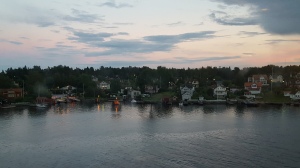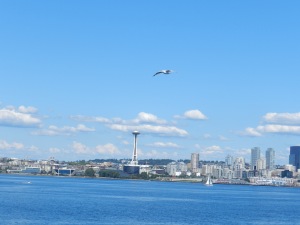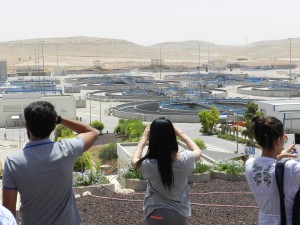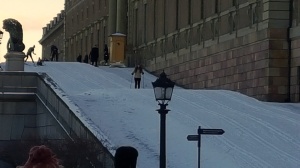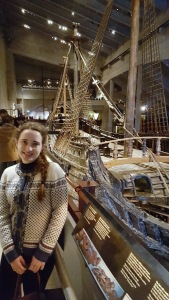 Wanting a bit of a relax after the whirlwind of the last night months, we chose a transatlantic cruise for our honeymoon on the Queen Mary 2. I’d always been curious what it would be like to cross the Atlantic by ship, but unsurprisingly several months on a small wooden ship with hard tack à la 1690 did not sound appealing. However, spending a week in an ocean liner with afternoon tea and dressing for dinner (more reminiscent of Gentlemen Prefer Blondes) sounded heavenly. (Not to mention a wooden-paneled library of 8,000 books!)
Wanting a bit of a relax after the whirlwind of the last night months, we chose a transatlantic cruise for our honeymoon on the Queen Mary 2. I’d always been curious what it would be like to cross the Atlantic by ship, but unsurprisingly several months on a small wooden ship with hard tack à la 1690 did not sound appealing. However, spending a week in an ocean liner with afternoon tea and dressing for dinner (more reminiscent of Gentlemen Prefer Blondes) sounded heavenly. (Not to mention a wooden-paneled library of 8,000 books!)
Unusually, the cruise we booked had a day stopover in Le Havre for its 500th anniversary before the usual seven night crossing. It was nice to explore Le Havre but also nice to start our days at sea. While the Atlantic is cool in September, we enjoyed our enclosed balcony that enabled us to drink tea or relax outside in colder or wetter weather than was ideal for the open decks. We were surprised at the number of events listed in our daily program (evening performances and dances; lessons on flower arranging, pilates, bridge, and more; planetarium shows; pub quizzes; and interesting lectures) in addition to the gym , pools, and spa. Not to mention the delicious dining options like a regular three course supper.
It was incredible how self-sufficient this little floating city was for a week. Imagine the logistics to ensure all those food choices for around 2,000 passengers. The staff were all amazing (something like 1243 personnel on board). We learned too late that you have to book the tours of the ship on the first day to get a slot anytime during the week; we’d wanted to understand better how it all works (and how they “make” their water). It was impossible not to marvel at the incredible accuracy required when you appreciated how extremely isolated we were. I think it was the second or third day at sea that I thought about how very in the middle of nowhere we were (also about this time they announced we were 100 miles north of the site of the Titanic) and how significant that seemed.
We admit our honeymoon choice was an unusual one–underscored by the fact that while we did meet another couple our age on their honeymoon, most passengers were 30-45 years our senior. But the only time that really mattered was in getting seats for events. While our generation shows up at the earliest about five minutes before start time, we would routinely be without a seat if we came fifteen minutes before an event began.
 But some things you didn’t need a seat for–like the sunsets. One of the best parts about heading west (besides an extra hour of sleep every night as we changed time zones) was that the front of the ship faced the sunset. We enjoyed the view once from the Commodore Club and another time from the top of the ship. So many options.
But some things you didn’t need a seat for–like the sunsets. One of the best parts about heading west (besides an extra hour of sleep every night as we changed time zones) was that the front of the ship faced the sunset. We enjoyed the view once from the Commodore Club and another time from the top of the ship. So many options.
Despite all the luxury, we most appreciated Queen Mary 2 when we hit the edges of Tropical Storm Hose on our last two days. Being on an ocean liner versus a regular cruise ship makes a significant difference during storms with winds at 11 on the Beaufort scale. (I personally felt very safe with the crew and just enjoyed the extra rocking though my dancing was off at the 1920s ball.) It was wonderful to wake up on Friday morning with the Statue of Liberty outside our window and the storm behind us.
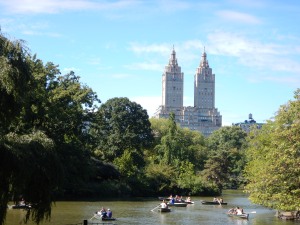 New York City offered the first warm, perfect weather of the trip, so we spent most of our time enjoying and exploring Central Park. I was excited to finally try out the rowboats and to catch up with a few people during our 24 hours there before we flew back to London.
New York City offered the first warm, perfect weather of the trip, so we spent most of our time enjoying and exploring Central Park. I was excited to finally try out the rowboats and to catch up with a few people during our 24 hours there before we flew back to London.
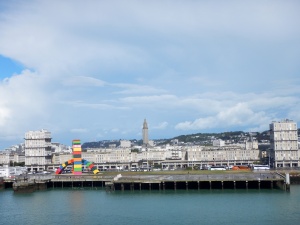 Our trip on the Queen Mary 2 made an unusual stop during its transatlantic crossing. We stopped in
Our trip on the Queen Mary 2 made an unusual stop during its transatlantic crossing. We stopped in 







 New York’s
New York’s 
